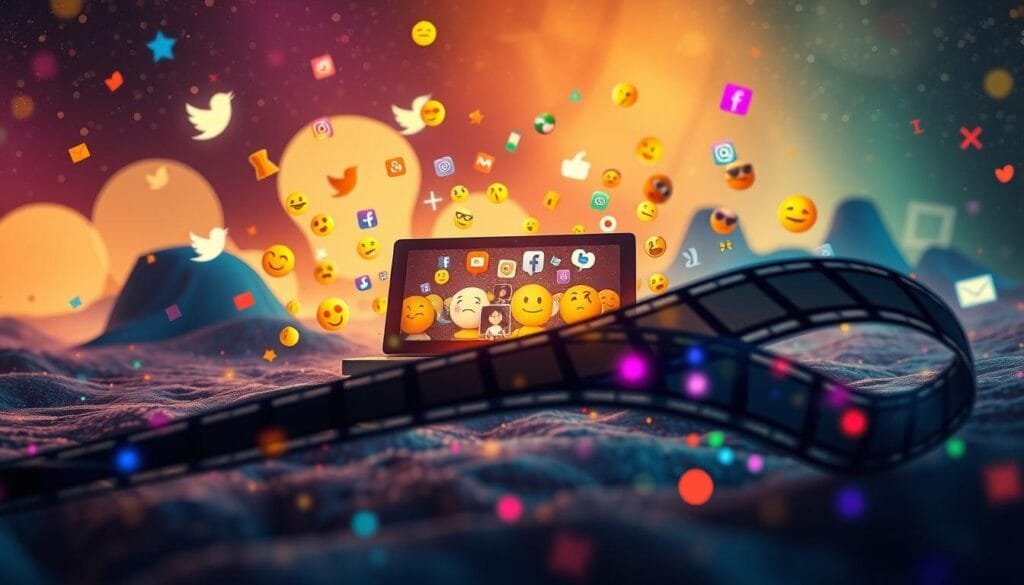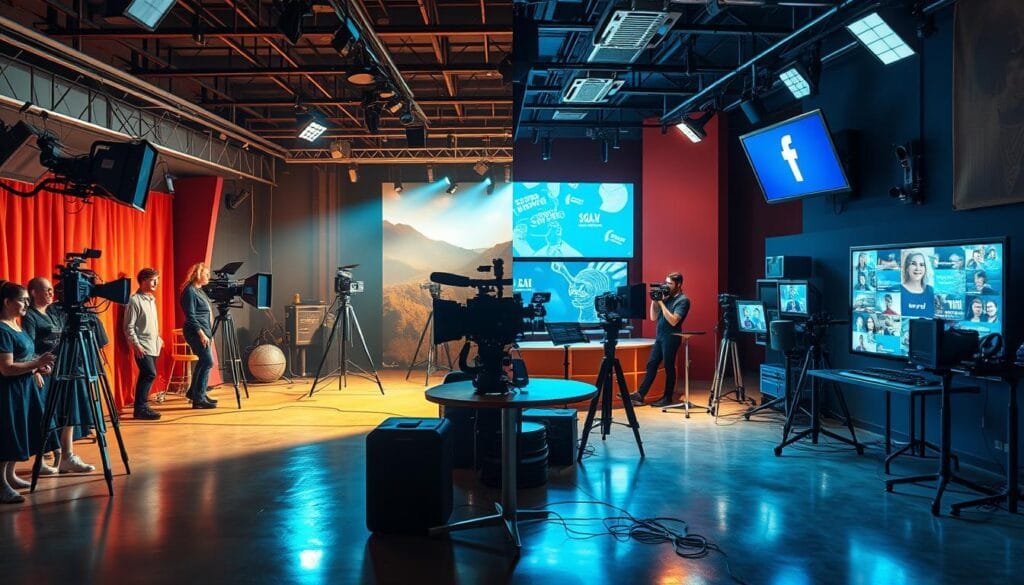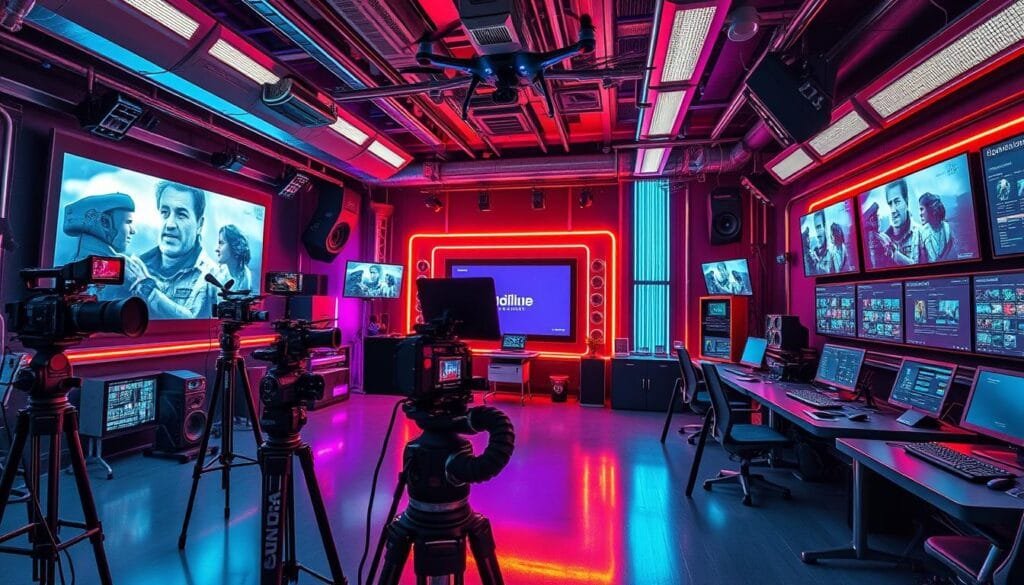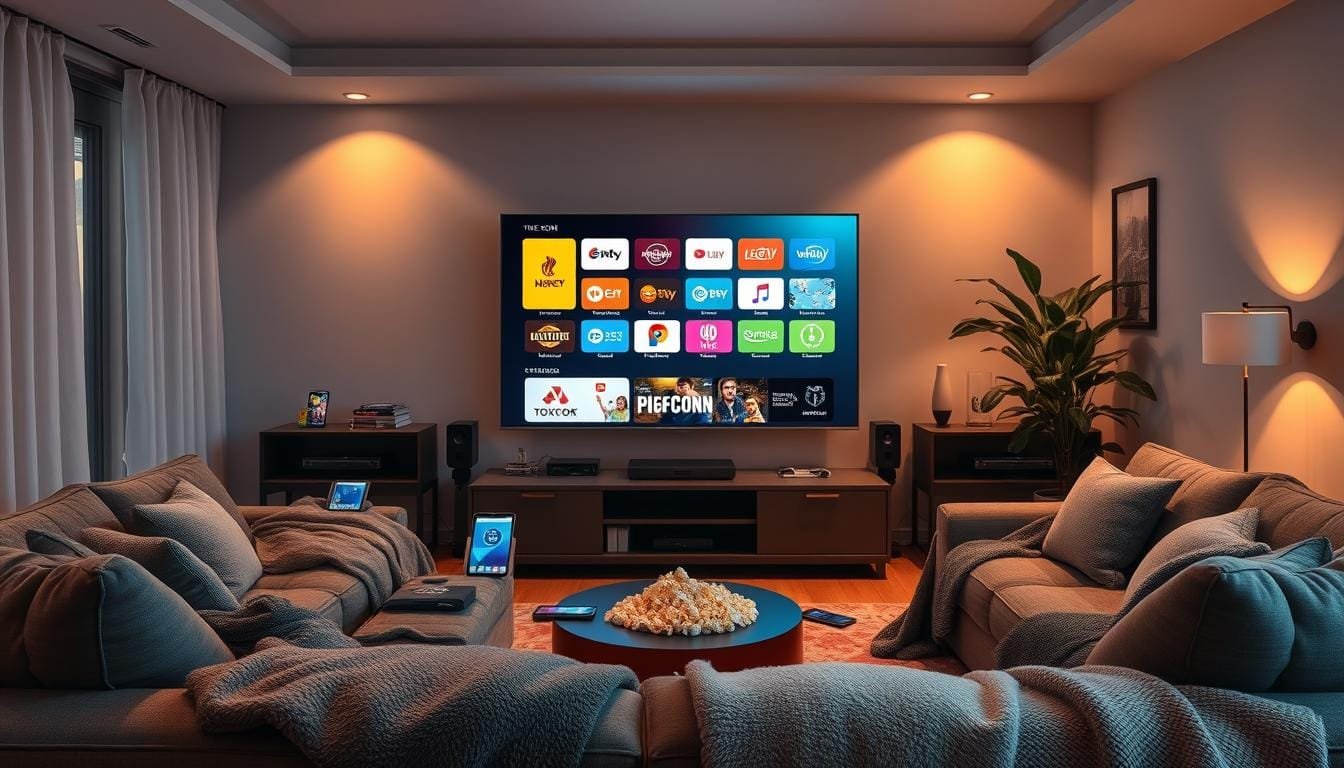Is traditional filmmaking dying because of internet culture, or is it just changing? As the impact of the Internet on the film industry grows, it’s important to look at how digital advancements are changing things. Streaming services and social media are reshaping and challenging cinema’s classic world.
The big question is whether this online culture of filmmaking is a drop in quality and creativity or just a new way to tell stories. By looking into the current situation, we see the internet might have changed filmmaking for the better, not ruined it.
Key Takeaways
- The rise of online streaming services and social media has significantly altered the film industry.
- Internet culture has prompted new challenges and opportunities in filmmaking.
- Quality, distribution, and reception of films are increasingly influenced by digital platforms.
- Debates continue on whether these changes signify a decline in creative standards or innovative evolution.
- Understanding the impact of internet culture is crucial for the future direction of filmmaking.
The Rise of Internet Culture
Our media habits have changed a lot because of the internet. Now, we see internet culture as a big part of entertainment. Movies and music have felt this shift deeply. Online streaming and social media have changed how stories are told and shared.
Advent of Online Streaming
Netflix, Spotify, and YouTube have changed how we watch movies and listen to music. They offer shows and songs that fit what you like. For example, Netflix suggests movies you might enjoy.
People used to watch TV at a set time. Now, they watch what they want, when they want. Spotify adds 60,000 songs every day. That’s a lot of choices. Streaming sites also like shows that keep you watching for hours. This has changed how stories are told.
Impact of Social Media on Filmmaking
Social media is now key for movie makers. It lets them talk directly to fans and build excitement for new movies. But, it also means people’s opinions spread fast.
On places like TikTok and Twitter, users respond to bold content quickly. A piece on Cinema Femme talks about this with the movie “Crash” (read more here). It shows how social media can shape what we think is normal.
Streaming and social media have really changed entertainment. As we look for shows and movies that fit us, creators need to keep up. They must find new ways to stay fresh and interesting in our digital world.
Changes in Film Criticism
Digital Film Criticism has changed a lot in the last few decades. It moved from traditional print to digital platforms. We now hear from a wide range of voices, including amateur and online critics.
From Print to Digital
Before, few famous critics in print media, like Pauline Kael and Roger Ebert, dominated film criticism. They influenced public opinions and steered cinema discussions. Film criticism started in the late 1800s, gaining popularity in the 1920s and 1930s with critics like Ricciotto Canudo and Bengt Idestam-Almquist.
Now, the internet gave rise to sites like Rotten Tomatoes and Metacritic. These sites collect reviews from critics and regular users. This change meant anyone could share their views, adding diverse perspectives. However, it sparked debate about the quality of film criticism.
| Traditional Print Critics | Online Critics | |
|---|---|---|
| Main Concern | Loss of Expertise | Accessibility and Diversity |
| Quality Debate | Expert-Driven Reviews | Amateur Film Reviews |
| Public Impact | Shaped by Expert Opinion | Rich Diversity of Voices |
| Pervasiveness | Limited Coverage | Instantaneous and Widespread |
The Influence of Amateur Critics
Amateur Film Reviews have a big impact today. Platforms like YouTube and Instagram let many share their views on films. This openness brings up issues like quality control and the risk of shallow reviews. Some say online writers seek clicks more than offering deep critiques, hurting cultural talks.
A single negative review can get lost among many positive ones. About 64% of critics want clearer labels for online content to show what’s genuine criticism and what’s promotion. Nearly 47% feel overwhelmed by too many opinions online. This shows a gap where detailed analyses don’t connect with the average viewer.
Digital Film Criticism has opened doors to many voices, but keeping quality and depth is tricky. The move from print to digital reviews reflects bigger shifts in how we consume culture, sparking ongoing debates about film criticism’s impact and future.
Influence of Real-Time Viewer Feedback
Today, movies are judged instantly on platforms like Twitter, Facebook, and Instagram. This changes how films are seen and how well they do. Quick feedback can really influence what people think and how much money a movie makes.
Social Media Reactions
Social media has a big say now. About 72% of folks talk about movies on social sites after seeing them. Meanwhile, 20% chat before and 8% during the movie. This wave of opinions can instantly persuade others. Big movie studios, with most of the film revenue, keep an eye on these reactions. They do this to understand what people think and to tweak their ads.

When movies don’t hit their mark, they’re quickly written off. Take “The Lone Ranger” from 2013. It made only $29.4 million in its first weekend on a $225 million budget. Before its launch, it had 21,156 social media mentions. On the other hand, a movie starring Robert Downey Jr. got 1,639,691 mentions. This shows how big a deal social media is for movies.
Instant Reviews and Ratings
Instant audience feedback is key. Most big movies make over 40% of their money right at the start. Early good reviews help a lot. Now, film studios try to get a strong first reaction to boost early sales. Yet, they often stick to safe, predictable movies to get a quick hit.
Social media shapes the story of new movies in just hours. With feedback coming so fast, the way movies are made and promoted keeps evolving. The collective voice of the audience is too powerful to overlook.
The Debate: Has Internet Culture Killed Filmmaking?
The internet has changed many industries, including filmmaking. Digital platforms have transformed how we create, produce, and engage with films. But, has this shift hurt the quality and uniqueness of movies? Let’s explore the important points of this debate.

The Impact on Creativity and Originality
The discussion on the Internet Impact on Creativity is crucial. With Netflix and Hulu leading, filmmakers feel pressured to please large, often global audiences. This can lead to movies that focus more on popularity than being original. The high cost of making a film, about $150 million, makes studios pick safer options like sequels and reboots over new ideas.
Yet, this change has also opened doors for unique voices through indie and crowd-funded projects. Sites like Kickstarter and Patreon have made it easier to fund creative projects without traditional studio limits. Still, it raises a question: are we promoting true creativity or just a lot of average content?
Shift in Audience Expectations and Preferences
The Changing Audience Preferences are key too. Today’s viewers want content right away and always look for something new and different. Social media lets viewers share their thoughts instantly, making them part of the creation process. This can be both good and bad for filmmakers. It offers insight into what people like, but it can also push them towards a predictable way of storytelling, based more on data than on art.
Also, people now prefer short, easy-to-watch content, thanks partly to YouTube and TikTok. Regular movies, which are usually about two hours long, have to compete with these quick, engaging videos. While this brings variety to what we watch, it also challenges filmmakers to find new ways to keep us interested.
| Trends | Impact |
|---|---|
| Digital Platforms | Broader, mass-appeal productions |
| Crowdfunding | Increased indie and creative projects |
| Real-Time Feedback | Formulaic content influenced by audience |
| Short-form content preference | Adapting traditional storytelling |
In summary, the Internet Impact on Creativity and Cultural Shift in Filmmaking have downsides. But, they also bring new, innovative ways and different voices to the film industry. The discussion is ongoing. Yet, it’s clear the internet has both challenged and widened the scope of filmmaking today.
The Role of Technology in Modern Filmmaking
In recent years, technology in filmmaking has greatly changed how movies are made. Now, we have digital filming and amazing special effects. This change started around 2000, transforming film production in big ways.

Take “The Lord of the Rings” and “The Hobbit” for example. “The Fellowship of the Ring” in 2001 had a $93 million budget. By 2012, “The Hobbit” cost about $180 million. This jump is largely due to digital innovations in cinema like CGI.
Looking at “Jurassic Park” in 1993 versus “Jurassic World” in 2018 shows a budget increase of 25%. But some fans think older movies had better effects. They prefer the effects in classics like “An American Werewolf in London” and “The Thing.”
Even though CGI is everywhere, it isn’t always cheaper. In fact, it can cost more than older methods. But CGI lets filmmakers create scenes that would otherwise be impossible. This shows the big tech impact on film production.
Color in movies has also changed. “Dune” (2021) uses cool greens, blues, and grays. This is different from the bright colors in “Lawrence of Arabia” (1962). Such changes come from new cinematography and editing tools.
Artificial intelligence (AI) is now part of writing and making movies. This brings new ways to be creative but also worries about losing traditional skills. Filmmakers have to find a good mix of new tech and classic methods.
Surveys show that 72% of young viewers use phones while watching movies. This influences how stories are told. Plus, 80% of directors say it’s harder to create suspenseful stories with today’s tech. Movies with smartphones tend to do well at the box office, showing tech’s big role in film.
Clearly, tech plays a huge part in how movies are made today. From digital cameras to AI, digital innovations in cinema are reshaping the industry. The key challenge is using these tools without losing the heart of traditional filmmaking.
Future of Filmmaking in the Digital Age
The future of cinema is an exciting story shaped by digital changes and new ways audiences connect with movies. We are seeing big changes in filmmaking thanks to digital tools. These changes have made it easier and more flexible to make, share, and enjoy films.
Adaptation and Evolution
The cinema world is changing fast because of new technology. Independent filmmakers play a big role in these changes. They get support from groups like the Independent Television Service (ITVS) and the Ford Foundation.
Digital advancements have changed how movies are made, copied, shared, and shown. This has made filmmaking more affordable and open. Now, more people can tell their stories through film.
| Aspect | Traditional Filmmaking | Digital Age Filmmaking |
|---|---|---|
| Production Costs | High | Reduced |
| Distribution | Limited to Theaters | Multiple Platforms |
| Replication | Physical Copies | Unlimited Digital Copies |
| Audience Reach | Restricted | Global |
Potential for Innovative Storytelling
Storytelling has grown with the digital age. Filmmakers now use digital cameras and editing tools to create in new ways. For example, *This is Not a Film* was made with just a cell phone camera. This shows how flexible and creative filmmaking can be.
Digital tech brings challenges like copyright issues and funding debates. Yet, the combined effort of TV networks, movie studios, tech firms, and unions helps solve these problems. By embracing digital advances, cinema will continue to offer diverse and captivating stories.
Conclusion
The world of filmmaking has seen big changes with the internet’s growth. Online streaming and social media have changed the game. The industry is moving away from old ways, as fewer people go to the movies now. Back in the 1930s, 90 million people would go weekly. Now, it’s closer to 30 million, even with more people around.
Big movies like “The Avengers” make a lot of money worldwide, showing how important online audiences are. Now, a big part of movie money comes from outside the U.S. This means movies are made to appeal globally. Yet, people still get excited about seeing movies in theaters. “Iron Man 2” made a huge amount at the box office, showing theaters still matter.
Movies are now shown digitally, which is cheaper and offers new options. But most moviegoers don’t notice the change from film to digital. This tech shift doesn’t bother them. We’re in a digital age, but we need to keep valuing the art of storytelling. The challenge is mixing technology with the need to tell great stories.
In the end, the internet has both helped and challenged filmmaking. It’s brought new ways to tell stories and reach audiences. Filmmakers are finding ways to use tech and art together. This mix keeps the film industry exciting and shows that movies will always be a way to share art and stories.
FAQ
How has the internet culture influenced the film industry?
The internet culture changed the film industry a lot. Now, we have new digital platforms and different ways to make films. The rise of online streaming services like Netflix and the impact of social media are big factors.
These changes affect how good the films are, how they are shared, and how we see them.
What are some effects of online streaming on audience viewing habits?
Online streaming platforms have changed how we watch films and TV shows. Services like Netflix let us watch what we want, anytime and anywhere. This has made fewer people go to the movies.
It also changed how and when films are released.
How does social media affect filmmaking?
Social media impacts filmmaking in two ways. It lets filmmakers connect with fans and spread the word about their movies. But, it also means films get judged very quickly online, which can affect their success.
Filmmakers now have to adjust how they market and make movies.
In what ways has film criticism evolved with the internet?
The internet made film criticism accessible to everyone, not just a few experts. Now, anyone can share their thoughts on movies online. This has brought more voices into the conversation.
But, it also makes us question the quality and trustworthiness of these opinions.
What is the role of real-time viewer feedback in the modern film industry?
Real-time feedback from viewers on social media and online reviews can really affect how people see a film. It lets filmmakers and studios quickly know what audiences think.
They can then change how they promote the film or even change the film itself.
Has internet culture led to a decline in creativity in filmmaking?
Some people worry that the internet has made filmmaking less creative. They think trying to please everyone online makes films less original. But, the need to keep coming up with new ideas can also be a good challenge.
It could bring out more creativity in filmmakers.
How have technological advancements other than the internet affected filmmaking?
Technology has changed filmmaking in many ways. For example, digital cameras, special effects, and AI in scriptwriting have made a big difference. These tools make filmmaking easier and open up new possibilities.
Yet, there’s a concern about keeping traditional filmmaking skills alive.
What might the future of filmmaking look like in the digital age?
In the future, filmmaking will keep changing and growing. Innovations in storytelling and engaging audiences will play a big role. Filmmakers can use these new tools to create films that really connect with people today.
